

Compact Muon Solenoid
LHC, CERN
| CMS-EXO-17-015 ; CERN-EP-2018-278 | ||
| Search for dark matter in events with a leptoquark and missing transverse momentum in proton-proton collisions at 13 TeV | ||
| CMS Collaboration | ||
| 26 November 2018 | ||
| Phys. Lett. B 795 (2019) 76 | ||
| Abstract: A search is presented for dark matter in proton-proton collisions at a center-of-mass energy of $\sqrt{s} = $ 13 TeV using events with at least one high transverse momentum (${p_{\mathrm{T}}}$) muon, at least one high-${p_{\mathrm{T}}}$ jet, and large missing transverse momentum. The data were collected with the CMS detector at the CERN LHC in 2016 and 2017, and correspond to an integrated luminosity of 77.4 fb$^{-1}$. In the examined scenario, a pair of scalar leptoquarks is assumed to be produced. One leptoquark decays to a muon and a jet while the other decays to dark matter and low-${p_{\mathrm{T}}}$ standard model particles. The signature for signal events would be significant missing transverse momentum from the dark matter in conjunction with a peak at the leptoquark mass in the invariant mass distribution of the highest ${p_{\mathrm{T}}}$ muon and jet. The data are observed to be consistent with the background predicted by the standard model. For the first benchmark scenario considered, dark matter masses up to 500 GeV are excluded for leptoquark masses ${{m_{\mathrm{LQ}}}} \approx$ 1400 GeV, and up to 300 GeV for ${{m_{\mathrm{LQ}}}} \approx$ 1500 GeV. For the second benchmark scenario, dark matter masses up to 600 GeV are excluded for ${{m_{\mathrm{LQ}}}} \approx$ 1400 GeV. | ||
| Links: e-print arXiv:1811.10151 [hep-ex] (PDF) ; CDS record ; inSPIRE record ; HepData record ; CADI line (restricted) ; | ||
| Figures | |
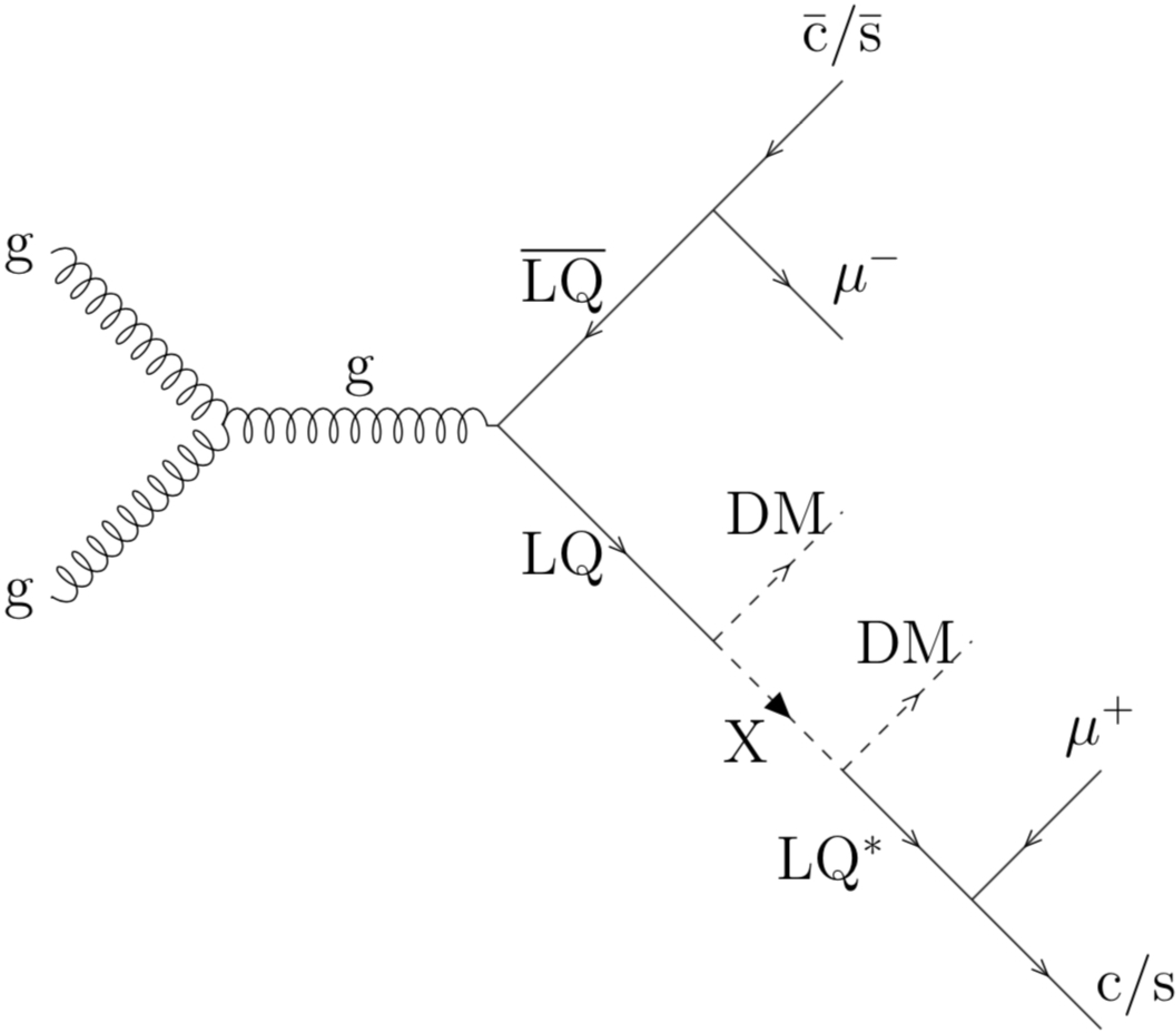
png pdf |
Figure 1:
An example Feynman diagram for the signal process considered in this study, where g is a gluon, LQ a leptoquark, DM a dark matter particle, and X a new Dirac fermion. The superscript "*'' indicates an off-shell particle. |
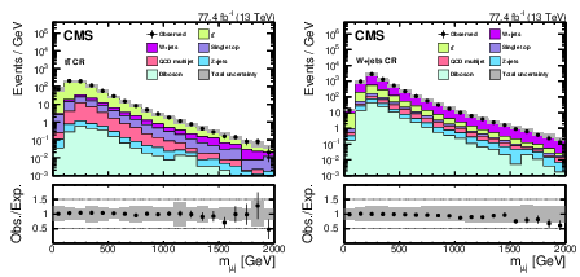
png pdf |
Figure 2:
The ${{m_{\mu \mathrm {j}}}}$ distributions in data and simulation for the (left) ${\mathrm{t} {}\mathrm{\bar{t}}} $- and (right) W+jets-enriched control samples for the combined 2016 and 2017 data sets. The respective data-to-simulation normalization scale factors have been applied to the simulated distributions. The lower panels show the ratio of the observed to the simulated results. The vertical error bars on the data points are statistical. The gray band shows the total uncertainty in the background prediction, including both statistical and systematic terms. |

png pdf |
Figure 2-a:
The ${{m_{\mu \mathrm {j}}}}$ distributions in data and simulation for the ${\mathrm{t} {}\mathrm{\bar{t}}} $-enriched control sample for the combined 2016 and 2017 data sets. The data-to-simulation normalization scale factors have been applied to the simulated distribution. The lower panel shows the ratio of the observed to the simulated results. The vertical error bars on the data points are statistical. The gray band shows the total uncertainty in the background prediction, including both statistical and systematic terms. |
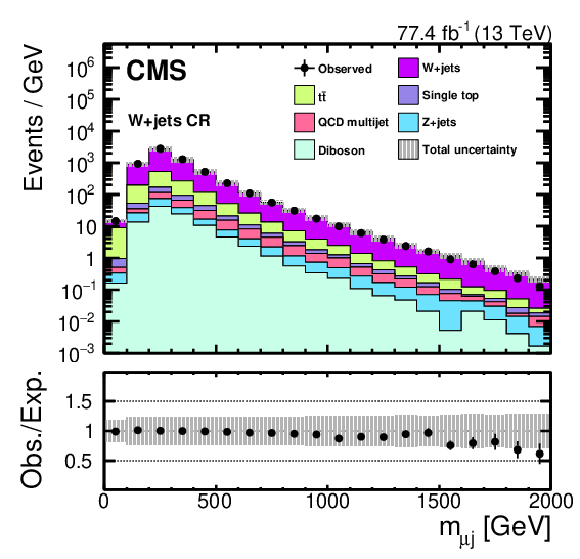
png pdf |
Figure 2-b:
The ${{m_{\mu \mathrm {j}}}}$ distributions in data and simulation for the W+jets-enriched control sample for the combined 2016 and 2017 data sets. The data-to-simulation normalization scale factors have been applied to the simulated distribution. The lower panel shows the ratio of the observed to the simulated results. The vertical error bars on the data points are statistical. The gray band shows the total uncertainty in the background prediction, including both statistical and systematic terms. |
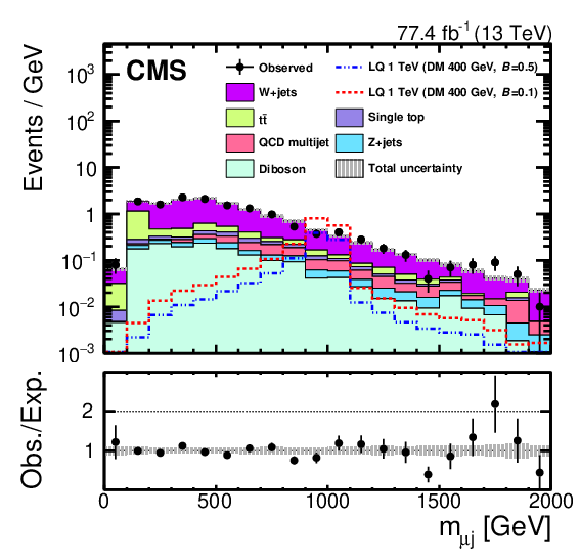
png pdf |
Figure 3:
The observed distribution of ${{m_{\mu \mathrm {j}}}}$ in comparison to the post-fit SM background predictions for the combined 2016 and 2017 data sets. "Post-fit'' means that the constraints from the maximum likelihood fit are incorporated. The unstacked predictions for two signal models with $ {{m_{\mathrm {LQ}}}} = $ 1000 GeV and $ {m_{\mathrm {DM}}} = $ 400 GeV are also shown: one with $ {B} =$ 0.5 and the other with $ {B} =$ 0.1. The difference is just an overall relative normalization of about 2 for the latter compared to the former. The ratio of the observed results to the total SM prediction is shown in the lower panel. The vertical error bars on the data points are statistical. The gray band shows the total uncertainty in the background prediction, including both statistical and systematic terms. |

png pdf |
Figure 4:
Observed 95% CL upper limits on the product of cross section and branching fraction for the signal model of Fig. 1 assuming $B = {\cal {B}}(\mathrm {LQ}\to {\mathrm {c}}\mu /\mathrm{s} \mu ) |_{{m_{\mathrm {DM}}} = {m_{{\mathrm {X}}}} =0} $ to be (left) 0.5 or (right) 0.1. The solid and dashed black curves show the observed and expected 95% CL exclusion curves, taking into account both upper and lower components of the LQ doublet. The solid blue curve shows the observed exclusion limit for the upper component of the LQ doublet, i.e. to a muon and a c quark. The dotted blue curve shows the corresponding observed limits from the recast of the results from a search for pair produced second-generation LQs [23]. |

png pdf |
Figure 4-a:
Observed 95% CL upper limits on the product of cross section and branching fraction for the signal model of Fig. 1 assuming $B = {\cal {B}}(\mathrm {LQ}\to {\mathrm {c}}\mu /\mathrm{s} \mu ) |_{{m_{\mathrm {DM}}} = {m_{{\mathrm {X}}}} =0} $ to be 0.5. The solid and dashed black curves show the observed and expected 95% CL exclusion curves, taking into account both upper and lower components of the LQ doublet. The solid blue curve shows the observed exclusion limit for the upper component of the LQ doublet, i.e. to a muon and a c quark. The dotted blue curve shows the corresponding observed limits from the recast of the results from a search for pair produced second-generation LQs [23]. |

png pdf |
Figure 4-b:
Observed 95% CL upper limits on the product of cross section and branching fraction for the signal model of Fig. 1 assuming $B = {\cal {B}}(\mathrm {LQ}\to {\mathrm {c}}\mu /\mathrm{s} \mu ) |_{{m_{\mathrm {DM}}} = {m_{{\mathrm {X}}}} =0} $ to be 0.1. The solid and dashed black curves show the observed and expected 95% CL exclusion curves, taking into account both upper and lower components of the LQ doublet. The solid blue curve shows the observed exclusion limit for the upper component of the LQ doublet, i.e. to a muon and a c quark. The dotted blue curve shows the corresponding observed limits from the recast of the results from a search for pair produced second-generation LQs [23]. |
| Tables | |
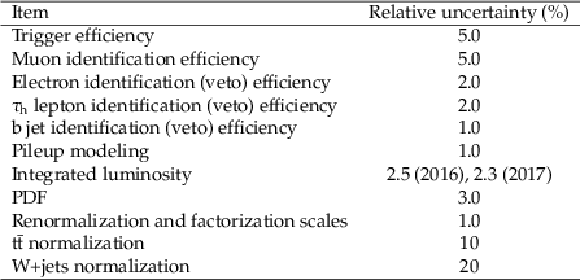
png pdf |
Table 1:
Systematic uncertainties affecting the normalization of signal and background distributions. The PDF uncertainty affects the signal distribution only, while the other uncertainties affect both the signal and background distributions. |

png pdf |
Table 2:
Observed number of events, post-fit SM background predictions and post-fit uncertainties for the combined 2016 and 2017 data sets. "Electroweak" refers to the sum of expected events from the single top quark, Z boson, and diboson background processes. The predictions for two signal models with $ {{m_{\mathrm {LQ}}}} = $ 1000 GeV and $ {m_{\mathrm {DM}}} = $ 400 GeV are also shown: one with $ {B} =$ 0.5 and the other with $ {B} =$ 0.1. The uncertainties represent the statistical and systematic terms added in quadrature. |
| Summary |
| A search has been performed for dark matter in events containing a muon, a jet, and significant missing transverse momentum. The study is conducted using proton-proton collision data at $\sqrt{s} = $ 13 TeV recorded with the CMS detector, corresponding to an integrated luminosity of 77.4 fb$^{-1}$. It is assumed that dark matter is produced through the production of a leptoquark pair, with one leptoquark decaying to a muon and a jet, and the other to dark matter and low-${p_{\mathrm{T}}}$ standard model particles. The analysis is performed by searching for a peak in the leptoquark candidate invariant mass ${{m_{\mu\mathrm{j}}}}$ distribution formed from the highest ${p_{\mathrm{T}}}$ muon and jet in an event, with the requirement of significant missing transverse momentum, as is expected from the presence of dark matter. The observation of such a peak in this novel search would provide strong evidence for the existence of both dark matter particles and leptoquarks. The data are observed to agree with the standard model background predictions within the uncertainties. Upper limits on the product of the cross section and branching fraction are obtained at 95% confidence level as a function of the leptoquark and dark matter particle masses. For the first benchmark scenario considered, dark matter masses up to 500 GeV are excluded for leptoquark masses ${{m_{\mathrm{LQ}}}} \approx$ 1400 GeV, and up to 300 GeV for ${{m_{\mathrm{LQ}}}} \approx$ 1500 GeV. For the second benchmark scenario, dark matter masses up to 600 GeV are excluded for ${{m_{\mathrm{LQ}}}} \approx$ 1400 GeV. |
| References | ||||
| 1 | G. Bertone, D. Hooper, and J. Silk | Particle dark matter: Evidence, candidates and constraints | PR 405 (2005) 279 | hep-ph/0404175 |
| 2 | J. L. Feng | Dark matter candidates from particle physics and methods of detection | Ann. Rev. Astron. Astrophys. 48 (2010) 495 | 1003.0904 |
| 3 | T. A. Porter, R. P. Johnson, and P. W. Graham | Dark matter searches with astroparticle data | Ann. Rev. Astron. Astrophys. 49 (2011) 155 | 1104.2836 |
| 4 | Particle Data Group, M. Tanabashi et al. | Review of particle physics | PRD 98 (2018) 030001 | |
| 5 | Planck Collaboration | Planck 2015 results. XIII. Cosmological parameters | Astron. Astrophys. 594 (2016) A13 | 1502.01589 |
| 6 | CMS Collaboration | Search for new physics in final states with an energetic jet or a hadronically decaying W or Z boson and transverse momentum imbalance at $ \sqrt{s}= $ 13 TeV | PRD 97 (2018) 092005 | CMS-EXO-16-048 1712.02345 |
| 7 | CMS Collaboration | Search for new physics in events with a leptonically decaying Z boson and a large transverse momentum imbalance in proton-proton collisions at $ \sqrt{s} = $ 13 TeV | EPJC 78 (2018) 291 | CMS-EXO-16-052 1711.00431 |
| 8 | CMS Collaboration | Search for new physics in the monophoton final state in proton-proton collisions at $ \sqrt{s}= $ 13 TeV | JHEP 10 (2017) 073 | CMS-EXO-16-039 1706.03794 |
| 9 | ATLAS Collaboration | Search for dark matter at $ \sqrt{s}= $ 13 TeV in final states containing an energetic photon and large missing transverse momentum with the ATLAS detector | EPJC 77 (2017) 393 | 1704.03848 |
| 10 | ATLAS Collaboration | Search for new phenomena in final states with an energetic jet and large missing transverse momentum in $ pp $ collisions at $ \sqrt{s}= $ 13 TeV using the ATLAS detector | PRD 94 (2016) 032005 | 1604.07773 |
| 11 | ATLAS Collaboration | Search for dark matter produced in association with a hadronically decaying vector boson in $ pp $ collisions at $ \sqrt{s} = $ 13 TeV with the ATLAS detector | PLB 763 (2016) 251--268 | 1608.02372 |
| 12 | ATLAS Collaboration | Search for dark matter and other new phenomena in events with an energetic jet and large missing transverse momentum using the ATLAS detector | JHEP 01 (2018) 126 | 1711.03301 |
| 13 | ATLAS Collaboration | Search for dark matter in events with a hadronically decaying vector boson and missing transverse momentum in $ pp $ collisions at $ \sqrt{s} = $ 13 TeV with the ATLAS detector | JHEP 10 (2018) 180 | 1807.11471 |
| 14 | CMS Collaboration | Search for dark matter produced in association with a Higgs boson decaying to $ \gamma\gamma $ or $ \tau^+\tau^- $ at $ \sqrt{s} = $ 13 TeV | JHEP 09 (2018) 046 | CMS-EXO-16-055 1806.04771 |
| 15 | B. Penning | The pursuit of dark matter at colliders--an overview | JPG 45 (2018) 063001 | 1712.01391 |
| 16 | M. J. Baker et al. | The coannihilation codex | JHEP 12 (2015) 120 | 1510.03434 |
| 17 | J. C. Pati and A. Salam | Unified lepton-hadron symmetry and a gauge theory of the basic interactions | PRD 8 (1973) 1240 | |
| 18 | J. C. Pati and A. Salam | Lepton number as the fourth color | PRD 10 (1974) 275, .[Erratum: \DOI10.1103/PhysRevD.11.703.2] | |
| 19 | H. Georgi and S. L. Glashow | Unity of all elementary particle forces | PRL 32 (1974) 438 | |
| 20 | H. Fritzsch and P. Minkowski | Unified interactions of leptons and hadrons | Annals Phys. 93 (1975) 193 | |
| 21 | B. Schrempp and F. Schrempp | Light leptoquarks | PLB 153 (1985) 101 | |
| 22 | I. Dor\vsner et al. | Physics of leptoquarks in precision experiments and at particle colliders | PR 641 (2016) 1 | 1603.04993 |
| 23 | CMS Collaboration | Search for pair production of second-generation leptoquarks at $ \sqrt{s}= $ 13 TeV | PRD 99 (2019) 032014 | CMS-EXO-17-003 1808.05082 |
| 24 | CMS Collaboration | The CMS experiment at the CERN LHC | JINST 3 (2008) S08004 | CMS-00-001 |
| 25 | CMS Collaboration | The CMS trigger system | JINST 12 (2017) P01020 | CMS-TRG-12-001 1609.02366 |
| 26 | CMS Collaboration | Particle-flow reconstruction and global event description with the CMS detector | JINST 12 (2017) P10003 | CMS-PRF-14-001 1706.04965 |
| 27 | CMS Collaboration | Performance of the CMS muon detector and muon reconstruction with proton-proton collisions at $ \sqrt{s}= $ 13 TeV | JINST 13 (2018) P06015 | CMS-MUO-16-001 1804.04528 |
| 28 | CMS Collaboration | Performance of electron reconstruction and selection with the CMS detector in proton-proton collisions at $ \sqrt{s} = $ 8 TeV | JINST 10 (2015) P06005 | CMS-EGM-13-001 1502.02701 |
| 29 | CMS Collaboration | Performance of reconstruction and identification of $ \tau $ leptons decaying to hadrons and $ \nu_\tau $ in pp collisions at $ \sqrt{s}= $ 13 TeV | JINST 13 (2018) P10005 | CMS-TAU-16-003 1809.02816 |
| 30 | M. Cacciari, G. P. Salam, and G. Soyez | The anti-$ {k_{\mathrm{T}}} $ jet clustering algorithm | JHEP 04 (2008) 063 | 0802.1189 |
| 31 | M. Cacciari, G. P. Salam, and G. Soyez | FastJet user manual | EPJC 72 (2012) 1896 | 1111.6097 |
| 32 | M. Cacciari and G. P. Salam | Pileup subtraction using jet areas | PLB 659 (2008) 119 | 0707.1378 |
| 33 | CMS Collaboration | Jet energy scale and resolution in the CMS experiment in pp collisions at 8 TeV | JINST 12 (2017) P02014 | CMS-JME-13-004 1607.03663 |
| 34 | CMS Collaboration | Pileup removal algorithms | CMS-PAS-JME-14-001 | CMS-PAS-JME-14-001 |
| 35 | CMS Collaboration | Identification of heavy-flavour jets with the CMS detector in pp collisions at 13 TeV | JINST 13 (2018) P05011 | CMS-BTV-16-002 1712.07158 |
| 36 | UA1 Collaboration | Experimental observation of isolated large transverse energy electrons with associated missing energy at $ \sqrt{s}= $ 540 ~GeV | PLB 122 (1983) 103 | |
| 37 | S. Frixione, P. Nason, and C. Oleari | Matching NLO QCD computations with parton shower simulations: the POWHEG method | JHEP 11 (2007) 070 | 0709.2092 |
| 38 | P. Nason | A new method for combining NLO QCD with shower Monte Carlo algorithms | JHEP 11 (2004) 040 | hep-ph/0409146 |
| 39 | S. Alioli, P. Nason, C. Oleari, and E. Re | A general framework for implementing NLO calculations in shower Monte Carlo programs: the POWHEG BOX | JHEP 06 (2010) 043 | 1002.2581 |
| 40 | S. Alioli, P. Nason, C. Oleari, and E. Re | NLO single-top production matched with shower in POWHEG: $ s $- and $ t $-channel contributions | JHEP 09 (2009) 111 | 0907.4076 |
| 41 | E. Re | Single-top Wt-channel production matched with parton showers using the POWHEG method | EPJC 71 (2011) 1547 | 1009.2450 |
| 42 | S. Frixione, P. Nason, and G. Ridolfi | A positive-weight next-to-leading-order Monte Carlo for heavy flavour hadroproduction | JHEP 09 (2007) 126 | 0707.3088 |
| 43 | J. Alwall et al. | The automated computation of tree-level and next-to-leading order differential cross sections, and their matching to parton shower simulations | JHEP 07 (2014) 079 | 1405.0301 |
| 44 | J. Alwall et al. | Comparative study of various algorithms for the merging of parton showers and matrix elements in hadronic collisions | EPJC 53 (2008) 473 | 0706.2569 |
| 45 | T. Sjostrand et al. | An introduction to PYTHIA 8.2 | CPC 191 (2015) 159 | 1410.3012 |
| 46 | CMS Collaboration | Event generator tunes obtained from underlying event and multiparton scattering measurements | EPJC 76 (2016) 155 | CMS-GEN-14-001 1512.00815 |
| 47 | R. Gavin, Y. Li, F. Petriello, and S. Quackenbush | FEWZ 2.0: A code for hadronic Z production at next-to-next-to-leading order | CPC 182 (2011) 2388 | 1011.3540 |
| 48 | Y. Li and F. Petriello | Combining QCD and electroweak corrections to dilepton production in FEWZ | PRD 86 (2012) 094034 | 1208.5967 |
| 49 | T. Melia, P. Nason, R. Rontsch, and G. Zanderighi | W$ ^+ $W$ ^- $, WZ and ZZ production in the POWHEG BOX | JHEP 11 (2011) 078 | 1107.5051 |
| 50 | M. Kramer, T. Plehn, M. Spira, and P. M. Zerwas | Pair production of scalar leptoquarks at the CERN LHC | PRD 71 (2005) 057503 | hep-ph/0411038 |
| 51 | M. Kramer, T. Plehn, M. Spira, and P. M. Zerwas | Pair production of scalar leptoquarks at the Tevatron | PRL 79 (1997) 341 | hep-ph/9704322 |
| 52 | NNPDF Collaboration | Parton distributions for the LHC Run II | JHEP 04 (2015) 040 | 1410.8849 |
| 53 | GEANT4 Collaboration | GEANT4--a simulation toolkit | NIMA 506 (2003) 250 | |
| 54 | CMS Collaboration | Measurement of the differential cross section for top quark pair production in pp collisions at $ \sqrt{s} = $ 8 TeV | EPJC 75 (2015) 542 | CMS-TOP-12-028 1505.04480 |
| 55 | CMS Collaboration | Measurement of differential top-quark pair production cross sections in pp collisions at $ \sqrt{s}= $ 7 TeV | EPJC 73 (2013) 2339 | CMS-TOP-11-013 1211.2220 |
| 56 | CMS Collaboration | Cross section measurement of $ t $-channel single top quark production in pp collisions at $ \sqrt s = $ 13 TeV | PLB 772 (2017) 752 | CMS-TOP-16-003 1610.00678 |
| 57 | CMS Collaboration | Measurement of differential cross sections for Z boson production in association with jets in proton-proton collisions at $ \sqrt{s} = $ 13 TeV | EPJC 78 (2018) 965 | CMS-SMP-16-015 1804.05252 |
| 58 | CMS Collaboration | Measurement of the inclusive W and Z production cross sections in pp collisions at $ \sqrt{s} = $ 7 TeV with the CMS experiment | JHEP 10 (2011) 132 | CMS-EWK-10-005 1107.4789 |
| 59 | CMS Collaboration | Performance of tau-lepton reconstruction and identification in CMS | JINST 7 (2012) P01001 | CMS-TAU-11-001 1109.6034 |
| 60 | CMS Collaboration | Reconstruction and identification of $ \tau $ lepton decays to hadrons and $ \nu_{\tau} $ at CMS | JINST 11 (2016) P01019 | CMS-TAU-14-001 1510.07488 |
| 61 | CMS Collaboration | Measurement of the inelastic proton-proton cross section at $ \sqrt{s}= $ 13 TeV | JHEP 07 (2018) 161 | CMS-FSQ-15-005 1802.02613 |
| 62 | R. Barlow and C. Beeston | Fitting using finite Monte Carlo samples | CPC 77 (1993) 219 | |
| 63 | CMS Collaboration | CMS luminosity measurements for the 2016 data taking period | CMS-PAS-LUM-17-001 | CMS-PAS-LUM-17-001 |
| 64 | CMS Collaboration | CMS Luminosity Measurements for the 2017 data-taking Period at $ \sqrt{s} = $ 13 TeV | CMS-PAS-LUM-17-004 | CMS-PAS-LUM-17-004 |
| 65 | CMS Collaboration | Jet algorithms performance in 13 TeV data | CMS-PAS-JME-16-003 | CMS-PAS-JME-16-003 |
| 66 | CMS Collaboration | Performance of missing energy reconstruction in 13 TeV pp collision data using the CMS detector | CMS-PAS-JME-16-004 | CMS-PAS-JME-16-004 |
| 67 | J. Butterworth et al. | PDF4LHC recommendations for LHC Run II | JPG 43 (2016) 023001 | 1510.03865 |
| 68 | T. Junk | Confidence level computation for combining searches with small statistics | NIMA 434 (1999) 435 | hep-ex/9902006 |
| 69 | A. L. Read | Presentation of search results: the $ \rm CL_s $ technique | JPG 28 (2002) 2693 | |
| 70 | G. Cowan, K. Cranmer, E. Gross, and O. Vitells | Asymptotic formulae for likelihood-based tests of new physics | EPJC 71 (2011) 1554 | 1007.1727 |
| 71 | The ATLAS Collaboration, The CMS Collaboration, The LHC Higgs Combination Group | Procedure for the LHC Higgs boson search combination in Summer 2011 | CMS-NOTE-2011-005 | |

|
Compact Muon Solenoid LHC, CERN |

|

|

|

|

|

|